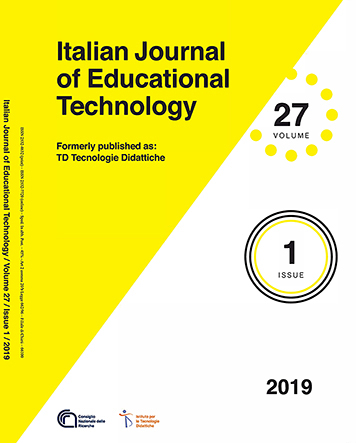L’ANALISI DEI TRACCIATI DELL’USO DEI COMPUTER PER SUPPORTARE IL COINVOLGIMENTO DEGLI STUDENTI NELLE ATTIVITÀ DI LABORATORIO
Contenuto principale dell'articolo
Abstract
Dettagli dell'articolo
Sezione
Gli autori che pubblicano su questa rivista accettano le seguenti condizioni:
- Gli autori mantengono i diritti sulla loro opera e cedono alla rivista il diritto di prima pubblicazione dell'opera, contemporaneamente licenziata sotto una Licenza Creative Commons CC BY 4.0 Attribution 4.0 International License.
- Gli autori possono aderire ad altri accordi di licenza non esclusiva per la distribuzione della versione dell'opera pubblicata (es. depositarla in un archivio istituzionale o pubblicarla in una monografia), a patto di indicare che la prima pubblicazione è avvenuta su questa rivista.
- Gli autori possono diffondere la loro opera online (es. in repository istituzionali o nel loro sito web) prima e durante il processo di submission, poiché può portare a scambi produttivi e aumentare le citazioni dell'opera pubblicata (Vedi The effect of Open Access).
Riferimenti bibliografici
Atif, A., Richards, D., Bilgin, A., & Marrone, M. (2013). Learning analytics in higher education: a summary of tools and approaches. Presented at the 30th Australasian Society for Computers in Learning in Tertiary Education Conference (ASCILITE 2013).
Barile, S., Magna L., Marsella, M., & Miranda, S. (1999). A marketing decision problem solved by application of neural networks”, Proceedings of Third International Conference on Computational Intelligence and Multimedia Applications ICIIMA (September 1999).
Bishop, C. M., (2006). Pattern recognition and Machine Learning. New York, NY, USA: Springer-Verlag.
Brookhart, S. (2013). The use of teacher judgement for summative assessment in the USA. Assessment in Education: Principles, Policy & Practice, 20(1), 69-90. doi: 10.1080/0969594X.2012.703170
Brown, M. (2011). Learning Analytics: The coming third wave. Louisville, CO, USA: EDUCAUSE Learning Initiative.
Chatti, M. A., Dyckhoff, A. L., Schroeder, U., & Thüs, H. (2012). A reference model for learning analytics. International Journal of Technology Enhanced Learning, 4(5-6), 318-331. doi: 10.1504/IJTEL.2012.051815
Cooper, A. (2012). What is analytics? Definition and essential characteristics [White paper]. CETIS Analytics series 1(5). Manchester, UK: The University of Bolton.
De-la-Fuente-Valentìn, L., Corbi, A., Crespo, R. G., & Burgos, D. (2015). Learning Analytics. In M. Khosrow-Pour (Ed.), Encyclopedia of Information Science and Technology, Third Edition (pp. 2379-2387). Hershey, PA: Information Science Reference. doi: 10.4018/978-1-4666-5888-2.ch231
Gaeta, M., Marzano, A., Miranda, S., & Sandkuhl, K. (2017). The competence management to improve the learning engagement. Journal of Ambient Intelligence and Humanized Computing, 8(3), 405-417. doi: 10.1007/s12652-016-0399-7
Lal, P. (2016). Designing Online Learning Strategies through Analytics. In F. J. García-Peñalvo & A. M. Seoane Pardo (Eds.), Online Tutor 2.0: Methodologies and Case Studies for Successful Learning (pp. 1-15). Hershey, PA, USA: IGI Global. doi:10.4018/978-1-4666-5832-5.ch001
Marzano, A., & Vegliante, R. (2017). Training to teach: the laboratory experience of General Didactic and Educational Technology at the University of Salerno. Formazione & Insegnamento, 1, 283-303.
Miranda, S., & Ritrovato, P. (2015). Supporting Learning Object Repository by automatic extraction of metadata. Journal of e-Learning and Knowledge Society, 11(1), 43-54.
Pardo, A., & Kloos, C. D. (2011). Stepping out of the box: towards analytics outside the learning management system. In Proceedings of the 1st International Conference on Learning Analytics and Knowledge (LAK '11). ACM, New York, NY, USA, 163-167. doi: 10.1145/2090116.2090142
Persico, D., & Pozzi, F. (2015). Informing learning design with learning analytics to improve teacher inquiry. British Journal of Educational Technology, 46(2), 230-248. doi: 10.1111/bjet.12207
Sampson, D. (2016). Learning Analytics: Analyze your lesson to discover more about your students, ELearning Industry. Retrieved from https://elearningindustry.com/learning-analytics-analyze-lesson
Scriven, M. (1967). The methodology of evaluation. In R. W. Tyler, R. M. Gagné, & M. Scriven (Eds.), Perspectives of curriculum evaluation (pp.39-83). Chicago, IL, USA: Rand-McNally.
Sah, M., & Hall, W. (2009). Building and managing personalized semantic portals. In Proceedings of the 16th International Conference on World Wide Web, 1227-1228.
Sergis, S., & Sampson, D. (2017). Teaching and Learning Analytics to support Teacher Inquiry: A Systematic Literature Review. In A. Peña-Ayala (Ed.), Learning Analytics: Fundaments, Applications, and Trends (pp. 25-63). New York, NY, USA: Springer.
Siemens, G., & Baker, R. (2012). Learning analytics and educational data mining: Towards communication and collaboration. In S. Buckingham Shum, D. Gašević, & R. Ferguson (Eds.), LAK '12 Proceedings of the 2nd International Conference on Learning Analytics and Knowledge (pp. 252-254). New York, NY, USA: ACM. doi: 10.1145/2330601.2330661
Trent, R. (June 29, 2015). Microsoft rolls out changes to family safety, renamed to Microsoft family. ITProToday. Retrieved from http://www.itprotoday.com/windows-server/microsoft-rolls-out-changes-family-safety-renamed-microsoft-family
Weurlander, M., Söderberg, M., Scheja, M., Hult, H., & Wernerson, A. (2012). Exploring formative assessment as a tool for learning: students’ experiences of different methods of formative assessment. Assessment & Evaluation in Higher Education, 37(6), 747-760. doi: 10.1080/02602938.2011.572153

